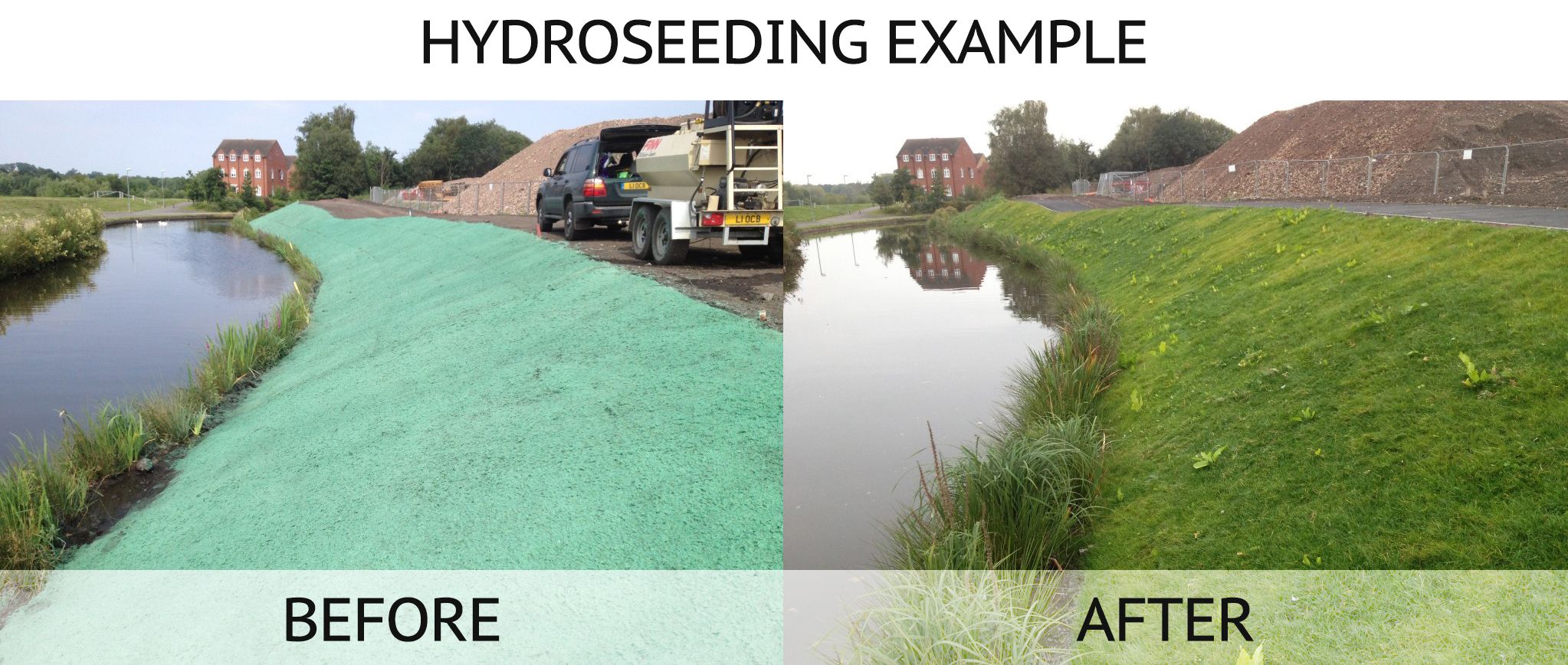
The Ultimate Guide to Hydroseeding – Everything you need to know!
Imagine a 1 mile stretch of bank on the side of a motorway that is simply mud. Now imagine you want that mudbank to be covered in green grass. How would you achieve it?
Option 1 – You could grab a basket with thousands of seeds and plant them manually. If you choose this option, make sure you tell your family you won’t be home for Christmas.
Option 2 – You could buy tonnes of ready made turf. But this mudbank will have lots of bumps and crevices on a very steep angle. Good luck, this will be very expensive indeed.
Option 3 – “Hydroseeding”. This is basically the process of spraying a seed mixture onto the bank using specialist hydroseeding machinery. It is similar to option 1 – but without all the heavy lifting and achieves a much fuller result.
In more detail, Hydroseeding is a planting process which involves the preparation of a liquid medium that combines seed and a carrier. This carrier is usually wood or paper fibre products with water. This is then mixed in a hydroseeding machine with mechanical agitation and recirculation and applied in liquid form to the seeding area.
Let’s rewind though and see the Hydroseeding machinery in motion. Here is footage from UK Hydroseeding contractor Oliver Brown spraying the seeds to create full coverage.
As you can see from the video. The mixture is sprayed onto the bank giving full coverage. This mixture of grass seeds will grow into a beautiful, vibrant evenly spread green grass bank. Laying turf here would be extremely difficult and potentially dangerous, while grass seeds will be exposed and may grow unevenly. In this video, mulch, seed and fertilizer are evenly distributed in the sprayed material. It is fast, simple and will get excellent results on this treacherous area.
Results are often quick with high germination rates producing grass growth in about a week and mowing maintenance beginning around 3 to 4 weeks from the date of application. Here is an example of a before and after shot of Hydroseeding.

The slurry in the “before” shot uses a high concentration of specialist inert organic fibres, tackifiers, biostimulants and fertilisers in order to boost germination and establishment.
Hydroseeding Smaller Areas
There is still an argument that using turf might be more beneficial for smaller service areas. Here we take a look at the pros and cons.
Turf Lawns: If you are looking for immediate results on a small lawn you may consider laying turf. Laying turf will require the lawn to be stripped to bare soil, as you will not want to lay turf over any existing grassland, plants or weeds. The most common misconception about turf is that people expect it can be grown anywhere; they expect instant success in any soil condition with little or no preparation. Before laying the turf you need to be sure the soil you laying it on is ready. You will then often need at least two weeks of intensive watering and general maintenance.
Hydroseeding: is a much more cost-effective way of installing a lawn and has less labour involved for large areas. Once the hydroseeding machine is set up, it takes very little additional effort to spray lawn over a larger area than a small one. Contrast that with the high material and labour cost to install turf, and hydroseeding is the clear choice for larger projects.
Hydroseeding Products
Flexterra
One of the most commonly used Hydroseeding products is Flexterra
- Immediately effective upon application—bonds directly to soil
- Superior erosion control—99% effective at multiple large-scale testing laboratories
- Excellent functional longevity that lasts through grow-in
- Fastest turf establishment—grows vegetation eight times faster than bare soil and twice as fast as rolled blankets
- Faster lay down and lower installed costs than rolled blankets
- Less soil preparation required versus rolled blankets
- Wildlife safe—no nets, threads or staples to entangle wildlife or mowing equipment
Hydroseeding machinery
Centrifugal pumps are better for spraying at long distances and Gear pumps can sometimes handle a little thicker slurry and will pump through longer lengths of hose than centrifugal pumps.
Centrifugal pumps are better for spraying at long distances.

Gear pumps can sometimes handle a little thicker slurry and will pump through longer lengths of hose than centrifugal pumps.

Conclusion
At its very core hydroseeding is about providing simplified solutions, being cost-effective, and being highly effective.
As technologies develop we can expect to see these solutions becoming more creative in order to deal with more advanced problems.
Cities and urban areas are expanding and the demand for clean green space is higher than ever; hydroseeding will lead the charge in reinvigorating our landscapes as the demand for quick and efficient solutions continues to grow.